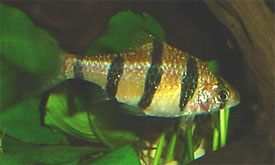
 Magyarul / Hungarian
Magyarul / Hungarian


- Scientific name: Desmopuntius pentazona
- Synonyms: Systomus pentazona, Puntius pentazona, Barbus pentazona, Capoeta pentazona, Fiveband barb
- Common name: Five-banded barb
- Group: Cyprinids
- Habitat: Southeast Asia; Borneo, Malay Peninsula, Singapore.
- Size: 5 cm
- Biotope: In stagnate pools and ponds, usually blackwater.
- Social behavior: In stagnate pools and ponds, usually blackwater.
- Diet: Flakes, live, crustaceans, insects, Tubifex, insect larvae.
- Breeding: Quite easy
- Tank: Minimum 80 litres
- Population: 8 fish for 100 litres
- Decoration: Plant the sides and edges with robust plants. Provide hiding places with rocks, roots, and wood. Use a dark colored substrate.
- Temperature: 22-26 °C
- pH: 6-6,5.
- Hardness: 5-10NK°
- Lifespan: 5-8 years
Description: An elongated, high backed barb with a pair of barbels. The back is olive brown to dark orange, while the flanks are orange-brown. The gill cover is red-orange and the throat and belly are white. The body is marked with five transverse bands. The first runs through the eye, while the last runs near the caudal penuncle. The fins may have a slight orange tint, although the anal and ventral fins are red. The eye is large in comparison to the rest of the body.
Males are more slender, smaller, and have brighter colors.
Use water with a pH from 5.5-6.0, a water hardness less than 5 dH, and a temperature from 81-86°F (27-30°C). The water should be peat filtered and clean. The pair should be conditioned together with insect larvae and flying insects. Use bunches of fine-leafed plants and marbles as a substrate so that the adults are not to eat their eggs. Spawning last from one to one and a half hours, and the parents should be fed with white worms throughout. Remove the pair immediately after spawning. 150-250 eggs will adhere to plants. These hatch after 28-30 hours, and the fry are free-swimming 4-5 days later. Start feeding with Infusoria and liquid foods. Later the fry can be fed Artemia nauplii. The fry are very sensitive to water pollutants and new water.














